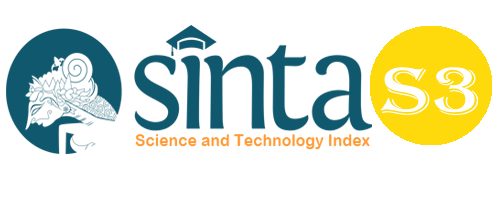Notes about Configuration of Organizational Justice and Social Capital: Impact on Satisfaction and Commitment
Abstract
This study is a review of Heru Kurnianto Tjahjono's article, Olivia Fach runnisa, Majang Palupina, Majang runnisa, in the International Journal of Business Excellence journal, Vol.17,No.3, 2019 with the title Configuration of organizational justice and social capital: their impact on satisfaction and commitment. This study argues that the limited information of individuals in responding to organizational policies forces them to judge fairness subjectively. Referring to social identity theory, this study proposes social capital as a key factor in explaining individual behavior in evaluating distributive justice and procedural justice. Individuals with high social capital tend to be group-oriented with different principles of justice. Using an experimental design, this study addresses the controversy over the impact of distributive and procedural justice on job satisfaction and organizational commitment. Substantial findings in this study explain that contextual aspects, such as distributive justice, procedural justice, and social capital, play a major role in elaborating organizational satisfaction and commitment.
Keywords
Full Text:
PDFReferences
Akdere, M. (2005), Social capital theory and implications for human resource development,Singapore Management Review, Vol. 27, No. 2, pp. 1-24 .
Akkoc, I., Altay, M. and Tuning, O. (2013), A longitudinal research on moderating effect of leader-member exchange on the relationships between leadership styles and job performance,International JournalofBusiness Excellence, Vol. 6, No. 6, pp.750-770.
Al-Kilani Hani, M. (2017), The Influence of organizational justice on intention to leave: examining the mediating role of organizational commitment and job satisfaction , Journal ofManagement and Strategy, Vol. 8, No. 1, pp. 1 8-27.
As’ad, M. 2002. Psikologi Industri (Seri Ilmu Sumber Daya Manusia). Penerbit Liberty, Yogyakarta
Aziri, B. (2011), Job satisfaction: a literature review, Management Research and Practice, Vol. 3,No. 4, pp.77-86.
Badawi, Tjahjono, H.K. and Muafi (2017), The role of corporate reputation moderation of banking services, Polish Journal of Management Studies, Vol. 15, No. I, pp.15-25.
Bajaj, H. and Krishnan, V.R. (2016), Role of justice perceptions and social exchange in enhancing employee happiness, International Journal of' Business Excellence, Vol. 9, No. 2,pp.192-209.
Bakhshi, A., Kumar, K. and Rani, E. (2009), Organizational justice perceptions as predictor of job satisfaction and organization commitment, International Journal of Business andManagement, Vol.4, No.9, pp. 145-154 .
Barling, J. and Philips, M. (1993), Interactional justice, formal and distributive justice in the procedural justice: an exploratory study, The Journal of Psychology, Vol. 649, No. 8, pp.1-4.
Brink, T. (2015), Passion and compassion represent dualities for growth International Journal ofOrganizational Analysis, Vol. 23, No: I, pp.41-60.
Christie, AM., Jordan, P.J. and Torch, A.C. (2015), Trust antecedents: emotional intelligence and perceptions of others, International Journal of' Organizational Analysis, Vol. 23, No. I,pp.89-101.
Chua, A. (2002), The influence of social interaction on knowledge creation, Journal of IntellectualCapital, Vol. 3, No. 4, pp.375-392 .
Clayton, S. and Opotow, S. (2003), Justice and identity: changing perspectives on what is fair,Personality and Social Psychology Review, Vol. 7, No. 4, pp.298-3 10.
Clayton, S. and Opotow, S. (2003), Justice and identity: changing perspectives on what is fair,Personality and Social Psychology Review, Vol. 7, No. 4, pp.298-3 10.
Colquitt, J.A. (2001), On the dimensionality of organizational justice: a construct validation of measure, Journal of Applied Psychology, Vol. 86, No. 3, pp.386-400.
Colquitt, J.A., Conlon, D.E., Wesson, M.J., Porter, C. and Ng, K.Y. (2001), Justice at the millennium: a meta-analytic review of 25 years of organizational justice research, Journal ofApplied Psychology, Vol. 86, No. 3, pp.425-445.
commitment. International Journal of Business Excellence, 17(3), 336-360.
Curry, J.P., Wakefield, D.S., Price, J.L. and Mueller, C.W. (1986), On the causal ordering of job satisfaction and organizational commitment, Academy oF Management Journal, Vol. 29,No. 4, pp.847-858.
Fachrunnisa, 0. (2012), Trust, self regulation and social movement: partner selection at digital collaboration network for SME's sustainability, International Journal of Trade, Economicsand Finance, Vol.3, No.6, pp.412-421.
Folger, R., and Konovsky, M. (1989), Effects of procedural and distributive justice on reactions to pay raise decisions, Academy of Management Journal, Vol. 32, No. I, pp.115-130.
Ghozali, 1. (2009), Aplikasi Analisis Multivariate dengan Program SPSS, Semarang: Badan Penerbit Universitas Diponegoro.
Gibson, C. (2001), Me and us: differential relationships among goal setting training, efficacy and effectiveness at the individual and team level, Journal of Organizational Behavior, Vol. 22,No. 7, pp.789-808 .
Gonçalves, 0., Reis, M., Sousa, C., Santos, J., Orgambidez-Ramos, A. and Scott. P. (2016), Cultural intelligence and conflict management styles, International Journal ofOrganizational Analysis, Vol. 24, No. 4, pp. 725-742 .
Harris, M.M., Lievens, F. and Hoye, G.V. (2004), I think they discriminated against me: using prototype theory and organizational justice theory for understanding perceived discriminationin selection and promotion situations, international Journal of Selection and Assessment,
Vol. 12, Nos. 1-2, pp.54-65.
Hartman, S.J., Yrle, A.C. and Galle, W.P.J. (1999), Procedural and distributive justice: examining equity in a university setting, Journal ofBusiness Ethics, Vol. 20, No. 4, pp.337-35 I.
Koshkin, A.P., Zhidkih, V.A. and Novikov, V.A. (2018), The role of social capital in the perception of images of the islamic state, Journal of Aggression. Conflict and PeaceResearch, Vol. 10, No. 1, pp.46-60.
Kostova, T. and Roth, K. (2003), Social capital in multinational corporations and micro-macro model of its formation, Academy of Management Review, Vol. 28, No. 2, pp.297-3 17.
Kuehl, R.O. (2000), Design of Experiments: Statistical Principles of Research Design and Analysis,2nd ed., Cengage Learning, Inc.
Laventhal, G.S. (1980), What should be done with equity theory? New approaches to the study of fairness in social relationships, in Gergen, K., Greenberg. M. and Willis. R. (Eds.): Social exc.Planum, New York.
Lilly, J.D. and Wipayangkool, K. (2017), When fair procedures don’t work: a self-threat model of procedural justice, Current Psychology, January, pp. 1-12 .
Magnier-Watanabe, R., Uchida, Orsini, P. and Benton, C. (2017), Organizational virtuousness and job performance in Japan: does happiness matter?, international Journal of Organizational Analysis, Vol. 25, No.4, pp.628-646.
Manning, P. (2017), The social capital concept in management and organizational literature,International Journal of Organizational Analysis, Vol. 25, No. 5, pp.875-893 .
Margaretha, M, dan Santosa, T,E,C, 2012, Keadilan Prosedural dan Keadilan Distributif sebagai Prediktor Employee Engagement, Jurnal Manajemen, Vol, 12, No, 1, 103-114.
Masterson, S., Lewis, K., Goldman, B.M. and Taylor, M.S. (2000), Integrating justice and social exchange: the differing effects of fair procedures and treatment on work relationships,Academy of Management Journal, Vol. 43, No. 4, pp. 738-748 .
Mathieu, J.E. and Zajac, D.M. (1990), A review and meta-analysis of the antecedents, correlates,and consequences of organizational commitment, Psychological Bulletin, Vol. 108, No. 2,pp. 17 1-194.
McFarlin, D. and Sweeney, P. (1992), Distributive and procedural justice as predictors of satisfaction with personal and organizational outcomes, Academy of Management Journal,Vol. 35, No. 3, pp.626-637.
Meyer, J.P. and Allen, N.J. (1991), A three-component conceptualization of organizational commitment', Human Resource Management Review, Vol. 1, No. 1, pp.6 1-89.
Mowday, R.T., Steers, R.M. and Porter, L.M. (1979), The measurement of organizational commitment, Journal of Vocational Behavior, Vol. 14, No. 2, pp.224-247.
Nahaphiet, J. and Ghoshal, S. (1998), Social capital, intellectual capital and the organizational advantage, Academy of Management Review, Vol. 23, No. 2. pp. 242-266 .
Niati, D. R., Siregar, Z. M. E., & Prayoga, Y. (2021). The Effect of Training on Work Performance and Career Development: The Role of Motivation as Intervening Variable. Budapest International Research and Critics Institute (BIRCI-Journal): Humanities and Social Sciences, 4(2), 2385–2393. https://doi.org/10.33258/birci.v4i2.1940
Ozel, A. and Bayraktar, C.A. (2017), Effect of organizational justice on job satisfaction, inCalisir, F. and Akdag, C.H. (Eds.): Lecture Notes in Management and Industrial EngineeringSpringer, pp.205-217
Palupi, M. and Tjahjono, H.K. (2016), A model of religiousity and organizational justice:the impact on commitment and dysfunctional behavior, Proceedings of the 27th InternationalConferences on Business Information Management Association, 4-5 May, Milan, Italy,pp. 1781-1790.
Podsakoff, P.M., MacKenzie, S.B., Lee, J.Y. and Podsakoff, N.P. (2003), Common method biases in behavioral research: a critical review of the literature and recommended remedies, JournalofApplied Psychology, Vol. 88, No. 5, pp. 879-903 .
Porter, L.W., Steers, R.M., Mowday, R.T. and Boulian, P.V. (1974), Organizational commitment,job satisfaction, and turnover among psychiatric technicians', Journal of Applied Psychology,July, Vol. 59, pp. 603-609
Primeaux, P., Karri, R. and Caldwell. C. (2003), Cultural insight to justice: a theoretical perspective through a subjective tense, Journal /Business Ethics. Vol. 46. No. 2, pp. 187-199.
Richard M. Steers, 1995. Efektivitas Organisasi: Kaidah Perilaku. Diterjemahkan kedalam bahasa Indonesia oleh Magdalena Jamin. Jakarta: LLPM dan Erlangga.
Robbins P. Stephen.2008. Perilaku Organisasi Organization Behaviour. Jakarta : Salemba Empat.
Robert, G.E. and Reed, T. (1996), Performance appraisal participation, goal setting and feedback:the influence of supervisory style. Review of Public Personnel A dill inistration. Vol. 16,No. 29, pp.29-60.
Sagala. Syaiful.2013. Etika dan Moralitas Pendidikan Peluang dan Tantangan. Jakarta : Kencana Prenada Media Group.
Saima, B. (2013), Developing organizational commitment and organizational justice to amplify organizational citizenship behavior in banking sector of Pakistan, Pakistan Journal ofCommerce and Social Sciences, Vol. 7, No. 3, pp.646-655.
Schaufeli, W,B, Salanova, M, GonzalezRoma, V, dan Bakker, A,B, 2002, The Measurement of Engagement and Burnout: A Two Sample Confirmatory Factor Analytic Approach, Journal of Happiness Studies, 3, 71-92.
Sekaran, U. and Bougie, R. (2010), Research Methods for Business: a Skill Building Approaches,5th ed., John Willey and Sons Ltd., Chichester.
Shah, M. M., et al. (2020). The Development Impact of PT. Medco E & P Malaka on Economic Aspects in East Aceh Regency. Budapest International Research and Critics Institute-Journal (BIRCI-Journal) Volume 3, No 1, Page: 276-286.
Shoaib, S. and Baruch, Y. (2017), Deviant behavior in a moderated-mediation framework of incentives, organizational justice perception, and reward expectancy, Journal of BusinessEthics, August, pp. 1-17 .
Stitka, L.J. (2003), Of different minds: an accessible identity model of justice reasoning,Personality and Social Psychology Review, Vol. 7, No. 4, pp.286-297.
Stitka, L.J. and Crosby, F.J. (2003), Trends in the social psychological study of justice,Personality and Social Psychology Review, Vol. 7, No. 4, pp. 286-297
Sweeney, P.D. and McFarlin, D.B. (1993), Workers evaluation of the ends and the means: an examination of four models of distributive and procedural justice, Organizational Behavior And Human Decision Processes, Vol. 55, pp.23-40.
Tamta. V. and Rao, M.K. (2017), The effect of organizational justice on knowledge sharing behavior in public sector banks in India: mediating role of work engagement, InternationalJournal of Business Excellence, Vol. 12, No. I, pp. 1-22.
Tang, T.L. and Baldwin, L.J. (1996), Distributive and procedural justice as related to satisfaction and commitment, SAMAdvanced Management Journal, Vol. 60, No. 4, pp.25-31.
Tjahjono, H. K., Fachrunnisa, O., & Palupi, M. (2019). Configuration of organizational justice and social capital: their impact on satisfaction and
Tjahjono, H.K. (2010), The extension of two-factor model of justice: hierarchical regression test and sample split, China-USA Business Review, Vol. 9, No. 7, pp. 39-54 .
Tjahjono,H.K. (2011), The configuration among social capital, distributive and procedural justice and its consequences to individual satisfaction, International Journal of Information andManagement Sciences, Vol. 22, No. 1, pp.87-103.
Werdhiastutie, A. et al. (2020). Achievement Motivation as Antecedents of Quality Improvement of Organizational Human Resources. Budapest International Research and Critics Institute-Journal (BIRCI-Journal) Volume 3, No 2, Page: 747-752.
Yosep Guntur Gathut Sujati, (2018). Kepuasan Kerja : Arti Penting, Faktor-faktor yang Mempengaruhi dan Implikasi bagi Organisasi, Universitas Sanata Dharma, Yogyakarta
DOI: https://doi.org/10.33258/birci.v5i1.4176
Article Metrics
Abstract view : 75 timesPDF - 24 times
Refbacks
- There are currently no refbacks.

This work is licensed under a Creative Commons Attribution-ShareAlike 4.0 International License.

This work is licensed under a Creative Commons Attribution-ShareAlike 4.0 International License.

_.gif)

















_.gif)



